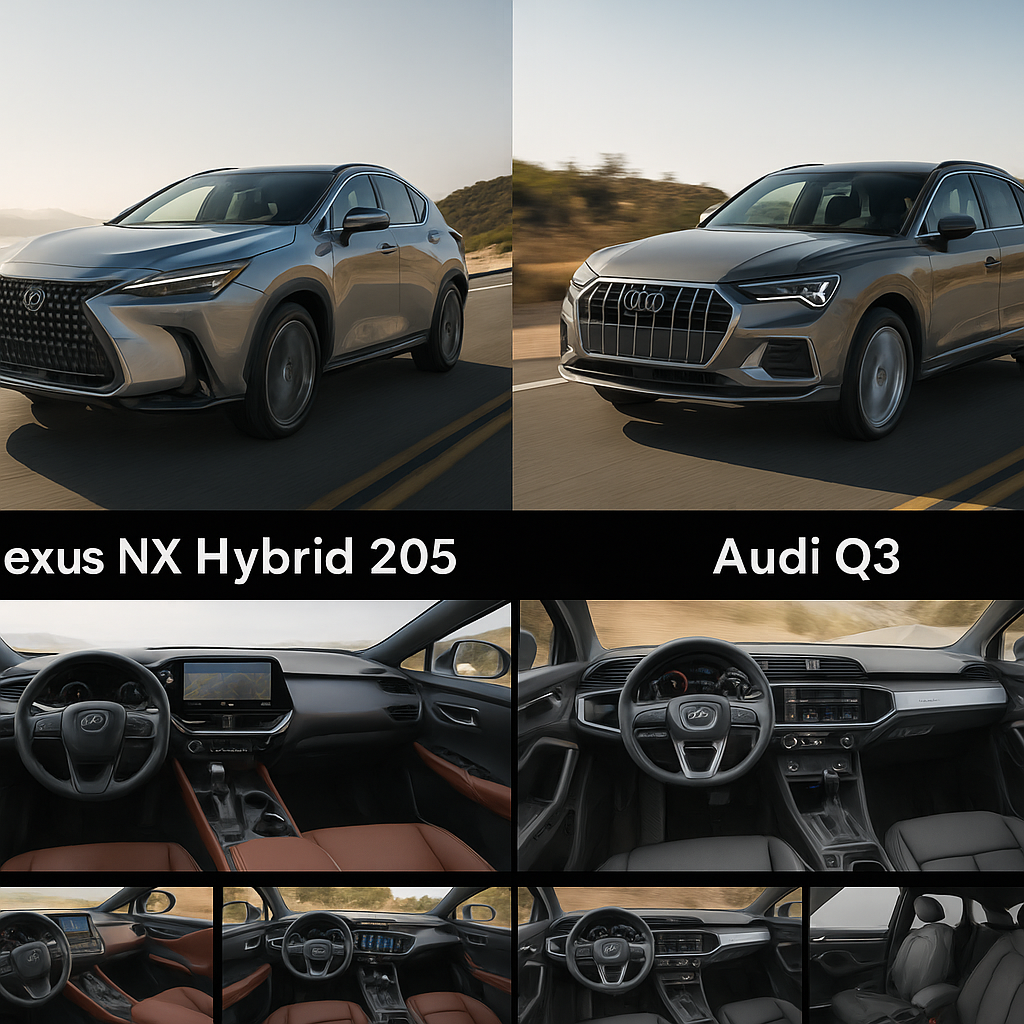When shopping for a luxury compact SUV in 2025, both the Lexus NX Hybrid and the Audi Q3 are bound to be on your shortlist. These two vehicles cater to buyers who want upscale interiors, cutting-edge technology, and a premium driving experience—but each brand takes a different approach to achieving those goals. In this post, we take a deep dive into the interior design, comfort, and technology of the 2025 Lexus NX Hybrid and the Audi Q3 to help you decide which one fits your lifestyle and expectations.
Interior Design Philosophy
The 2025 Lexus NX Hybrid showcases the Japanese brand’s focus on elegance and futuristic design. The cabin is wrapped in high-quality synthetic or real leather, depending on the trim, with ambient lighting options that can be personalized through the Lexus Interface. A distinctive “Tazuna” cockpit layout places controls intuitively around the driver for a minimalist, uncluttered feel.
The Audi Q3, on the other hand, leans into its European sophistication. Its interior feels clean, angular, and functional with a strong emphasis on symmetry. Materials are top-notch, including brushed aluminum accents and soft-touch surfaces. The Q3’s cabin has a slightly more traditional luxury feel compared to the tech-forward ambiance of the Lexus.
Dashboard Layout and User Experience
The Lexus NX Hybrid features a massive 14-inch touchscreen display (standard in most trims), dominating the dashboard with a seamless integration of navigation, entertainment, and climate functions. Physical buttons are minimal, replaced with soft-touch haptic surfaces and voice-activated controls using the Hey Lexus assistant. Lexus has also included a fully digital driver display, head-up display, and ambient soundscapes.
Audi takes a more tactile approach. The Q3 offers a 10.1-inch MMI touchscreen paired with a 10.25-inch digital instrument cluster (Audi Virtual Cockpit). The system is intuitive and responsive, offering clean menus and sharp graphics. Unlike the NX, Audi retains more physical buttons for climate and quick-access functions, which some drivers may prefer for ease of use.
Comfort and Seating
Lexus puts a strong emphasis on comfort with its NuLuxe synthetic leather seats that are both ventilated and heated. The 2025 NX Hybrid also offers power-adjustable front seats with memory settings, a heated steering wheel, and even optional rear seat heating. Sound insulation is exceptional, making it feel almost whisper-quiet inside, even on busy highways.
Audi counters with sportier front seats, also available heated, with firm bolstering and supportive design. The Q3’s leather upholstery is soft to the touch and the rear seats are surprisingly spacious for a compact SUV. Still, the ride can feel firmer than the Lexus, especially on the optional sport suspension.
Infotainment and Connectivity
In terms of infotainment, the Lexus NX Hybrid is ahead in both screen size and connectivity. It supports wireless Apple CarPlay and Android Auto, plus an available 10-speaker Mark Levinson audio system for audiophiles. The Lexus Interface software has improved significantly in responsiveness and over-the-air update capabilities.
Audi’s MMI system is no slouch, offering wired and wireless Apple CarPlay and Android Auto, Amazon Alexa integration, and available Bang & Olufsen sound. However, screen real estate is smaller, and Audi’s system requires a slightly steeper learning curve.
Ambient Lighting and Mood
Both SUVs offer ambient lighting, but Lexus brings a more customizable experience. The NX Hybrid provides 64-color ambient lighting, which can be pre-set into mood themes like “Rain Forest” or “Sunset.” This feature enhances the luxury feel and can change dynamically based on drive mode.
The Audi Q3 includes 10-color ambient lighting that offers subtle accents across the doors and footwells. It’s elegant but less immersive compared to Lexus’s futuristic setup.
Cargo and Practical Tech Features
The Lexus NX Hybrid includes 22.7 cubic feet of cargo space behind the second row and up to 46.9 cubic feet with the seats down. Audi offers slightly more cargo space at 23.7 cubic feet, expanding to around 48 cubic feet with the seats folded.
Other practical features in both models:
Wireless charging pads
Multiple USB-C ports
Remote vehicle functions via smartphone apps
Over-the-air software updates
Surround-view cameras (standard on higher trims)
Driver Assistance and Tech Features
Both the NX Hybrid and Q3 come loaded with driver-assist technology, but Lexus again goes more advanced with Lexus Safety System+ 3.0, which includes:
Predictive pedestrian detection
Lane change assist
Intersection assist
Dynamic radar cruise control
Audi Q3 includes Audi Pre Sense Front, adaptive cruise control, and lane departure warning, but lacks some of the predictive tech seen in the Lexus.
Which Interior and Tech Setup Is Better?
Choose the 2025 Lexus NX Hybrid if you want:
A tech-forward interface with a huge touchscreen
Ultra-quiet ride and mood lighting
More luxurious driver-assist features
Greater screen customization and audio upgrades
Choose the Audi Q3 if you value:
A sportier, more driver-focused layout
Simple physical controls blended with clean digital displays
Traditional luxury aesthetics
Slightly more usable cargo space
Final Verdict: Tech Lover vs. Driving Enthusiast
In this interior and technology-focused comparison, the Lexus NX Hybrid is the clear winner for tech lovers and comfort-seekers. It’s ideal for buyers who prioritize a premium digital interface, intuitive AI features, and relaxing cabin atmosphere. Meanwhile, the Audi Q3 is better suited for drivers who favor clean design, driver-oriented controls, and a classic luxury experience with German precision.
Either way, both SUVs offer standout interiors in the compact luxury segment—your final choice will depend on your driving habits and what you value most in cabin tech.
